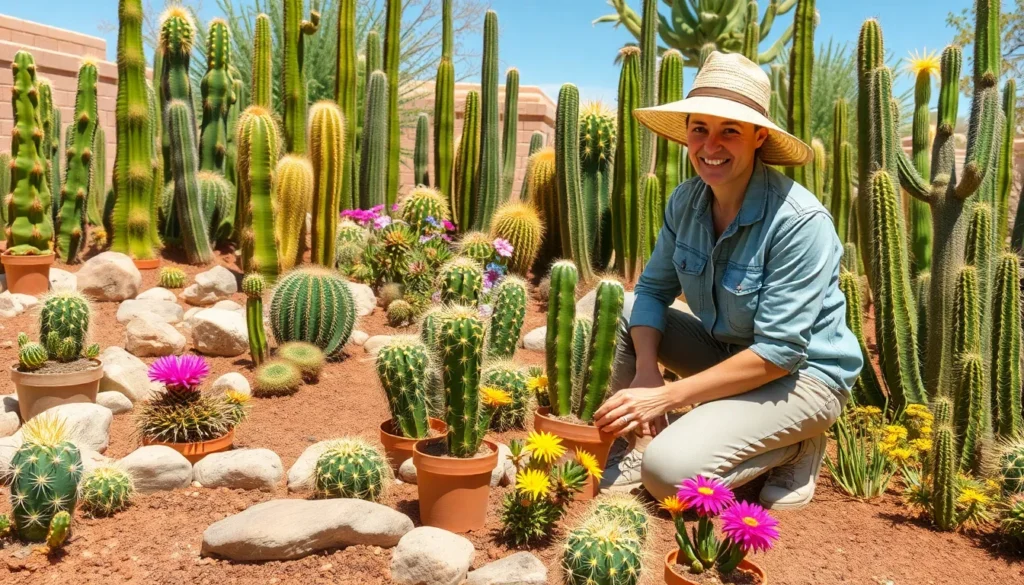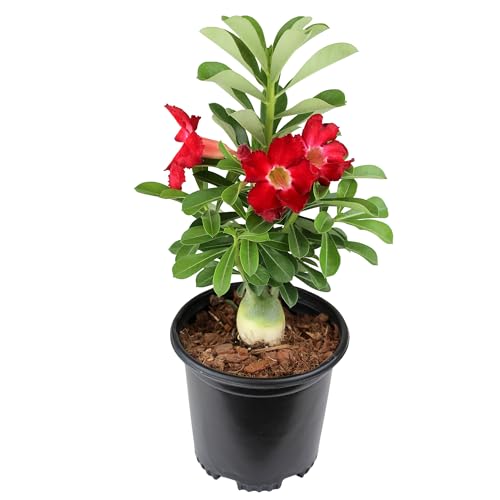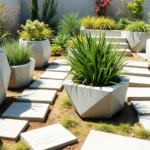We’ve all fallen in love with the striking beauty of cacti and their incredible ability to transform any space into a desert oasis. Whether you’re dealing with a small balcony or expansive backyard, cacti offer endless possibilities for creating stunning, low-maintenance gardens that’ll leave your neighbors envious.
Cactus gardens aren’t just trendy – they’re practical answers for busy homeowners who want gorgeous landscapes without the constant watering and upkeep. From miniature indoor arrangements to sprawling outdoor desert scenes, these resilient plants adapt to virtually any setting while adding dramatic texture and unique character.
We’re about to share game-changing ideas that’ll help you design the perfect cactus garden for your space and lifestyle. You’ll discover creative arrangements, companion planting strategies, and design tricks that maximize visual impact while keeping maintenance to an absolute minimum.
Choose the Perfect Location for Your Cactus Garden
Success with your cactus garden starts with selecting the right spot in your outdoor space. We’ll guide you through the essential factors that determine where these desert beauties will thrive best.
Assess Sunlight Requirements
Most cacti need at least 6 hours of direct sunlight daily to maintain their vibrant colors and compact growth patterns. We recommend observing your potential garden areas throughout different times of day to identify which spots receive the most consistent sun exposure.
South-facing locations typically provide the strongest and longest duration of sunlight. Areas near reflective surfaces like white walls or concrete can intensify light levels and create ideal growing conditions for sun-loving varieties like barrel cacti and prickly pears.
Some cactus species like Christmas cacti and certain forest cacti prefer filtered sunlight or partial shade conditions. We suggest placing these varieties in spots that receive morning sun but afternoon protection from intense rays.
Evaluate Drainage Conditions
Proper drainage ranks as the most critical factor for cactus garden success since waterlogged soil kills these plants faster than drought conditions. We test drainage by digging a hole 12 inches deep and filling it with water to see how quickly it drains.
Well-draining locations should empty completely within 2 to 4 hours after heavy rainfall. Areas that hold standing water for more than 6 hours require soil amendments or raised bed construction to prevent root rot.
Sloped areas naturally provide excellent drainage and work perfectly for most cactus varieties. We often recommend hillsides, raised garden beds, or even slightly elevated mounds to ensure excess water flows away from plant roots.
Consider Climate Factors
Hardy cactus species can survive temperatures as low as -20°F while tender varieties require protection when temperatures drop below 50°F. We match our plant selections to local winter temperature ranges to ensure long-term garden success.
Wind exposure affects both cold hardiness and watering needs in cactus gardens. Protected areas near buildings or fences provide shelter from drying winds while still allowing adequate air circulation around plants.
Humidity levels above 50% can cause problems for desert cacti that prefer arid conditions. We position cactus gardens in areas with good air movement and avoid low-lying spots where moisture tends to collect during humid weather.
Select the Right Cactus Varieties for Your Space
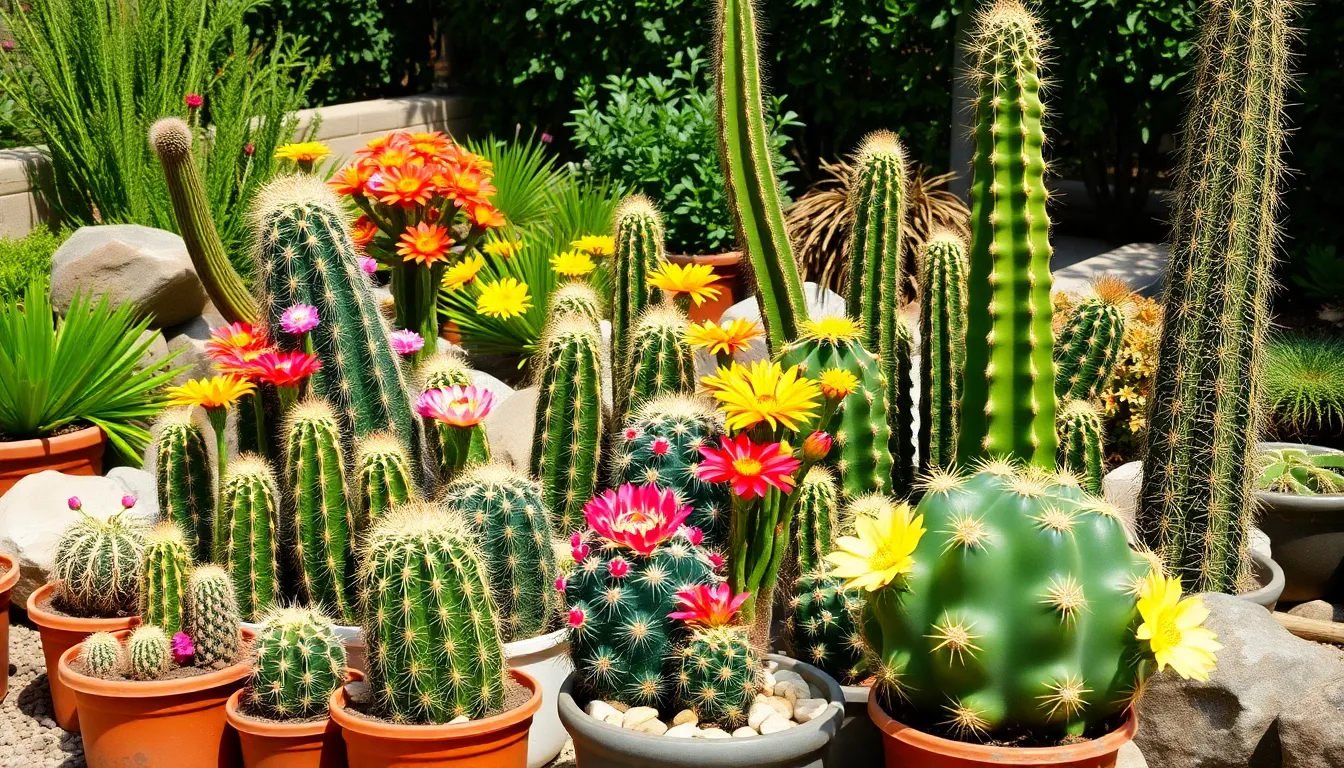
Choosing the perfect cactus varieties transforms your garden design from ordinary to extraordinary. We’ll guide you through selecting species that thrive in your exact climate and space requirements.
Determine Cold Hardy Options
Cold hardy succulents and cacti provide stunning beauty even in areas with frost conditions. Ocotillo stands as an excellent choice for regions experiencing occasional freezing temperatures, displaying dramatic red blooms when conditions align perfectly. Chin cactus offers remarkable frost tolerance while maintaining compact growth patterns that suit smaller garden spaces.
These resilient varieties withstand temperature drops that would damage tropical cactus species. We recommend researching your local hardiness zone before selecting cold tolerant options for your industry design. Many hardy cacti actually benefit from winter dormancy periods, producing more vibrant growth and blooms the following season.
Pick Colorful Flowering Species
Flowering cacti create spectacular focal points that rival traditional blooming plants in visual impact. Christmas cactus delivers brilliant red, pink, or white flowers during winter months when most gardens lack color. Prickly pear cactus produces stunning yellow, orange, or pink blooms that attract beneficial pollinators to your garden space.
Blooming conditions require exact care adjustments including reduced watering and cooler temperatures during dormancy periods. We suggest grouping flowering varieties together to create concentrated color displays that maximize visual impact. These colorful species often need more consistent moisture than desert cacti, making them perfect for partially shaded garden areas.
Choose Size-Appropriate Plants
Size appropriate plants ensure your cactus garden maintains proper proportions and visual balance throughout the growing season. Small varieties like barrel cactus work perfectly in container gardens or as border plants along walkways. Medium sized species such as columnar cacti create dramatic vertical elements without overwhelming smaller garden spaces.
Large specimens including tree cacti serve as stunning centerpieces but require adequate spacing for future growth patterns. We recommend considering mature sizes when planning your layout, as many cacti grow slowly but can eventually reach impressive dimensions. This planning approach prevents overcrowding issues that compromise both plant health and garden aesthetics.
Design a Desert-Themed Rock Garden Layout
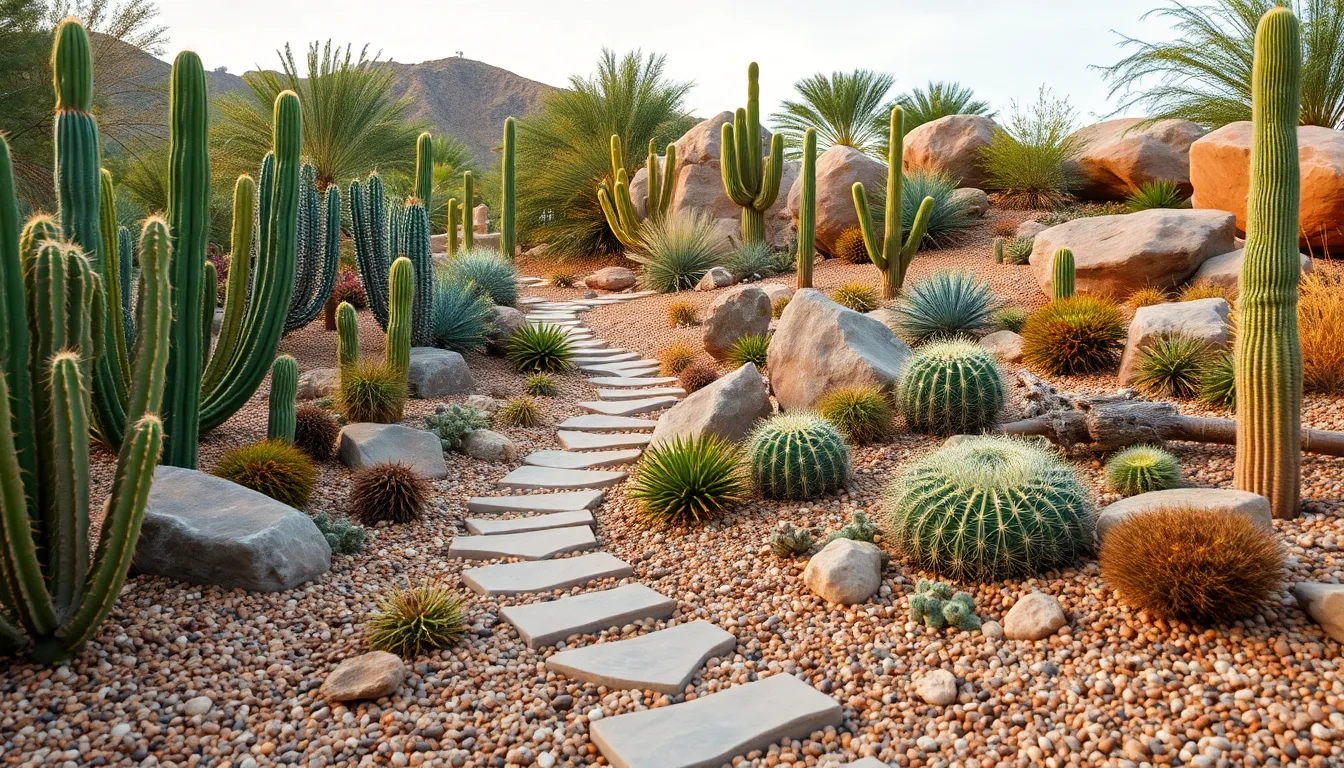
Transforming our cactus garden into an authentic desert industry requires thoughtful integration of hardscape elements that complement our carefully selected plants. Rock features create the foundation for a cohesive desert aesthetic while providing practical benefits for plant health and garden maintenance.
Create Natural Stone Pathways
Natural stone pathways guide visitors through our cactus garden while defining distinct viewing areas and plant zones. We can use flagstone, sandstone, or decomposed granite to create winding paths that mimic the organic flow of desert terrain. Irregular stone shapes work better than uniform pavers because they create a more authentic desert appearance.
Spacing stones 12-18 inches apart allows desert plants to grow between pathway elements, softening the hardscape’s appearance. We should consider the pathway’s width based on our garden’s scale, with 3-4 feet being ideal for comfortable walking and wheelchair accessibility. Strategic placement of stepping stones near focal cacti creates intimate viewing spots without disturbing root systems.
Incorporate Decorative Gravel Mulch
Decorative gravel mulch serves multiple functions in our desert-themed cactus garden by improving drainage, suppressing weeds, and improving visual appeal. We can choose from various gravel types including decomposed granite, pea gravel, or crushed rock in colors that complement our stone pathways and cactus selection.
Application depth of 2-3 inches provides optimal weed suppression while allowing proper air circulation around cactus bases. Different gravel sizes create textural variety, with smaller gravels working well around delicate cacti and larger stones complementing bold specimens. We should avoid organic mulches like wood chips since they retain moisture and can promote root rot in desert plants.
Add Sculptural Boulder Features
Large boulders serve as dramatic focal points that anchor our desert garden design while providing natural seating and wildlife habitat. We can position weathered sandstone or granite boulders to create visual weight and establish different garden zones. Grouping boulders in odd numbers following natural rock formations creates the most authentic appearance.
Strategic boulder placement near pathways offers resting spots for garden visitors while creating microclimates for smaller cacti. We should partially bury boulders to achieve a natural, settled appearance rather than placing them directly on the soil surface. Varying boulder sizes from small accent rocks to substantial statement pieces adds depth and prevents the garden from appearing too uniform.
Build Raised Beds for Optimal Drainage
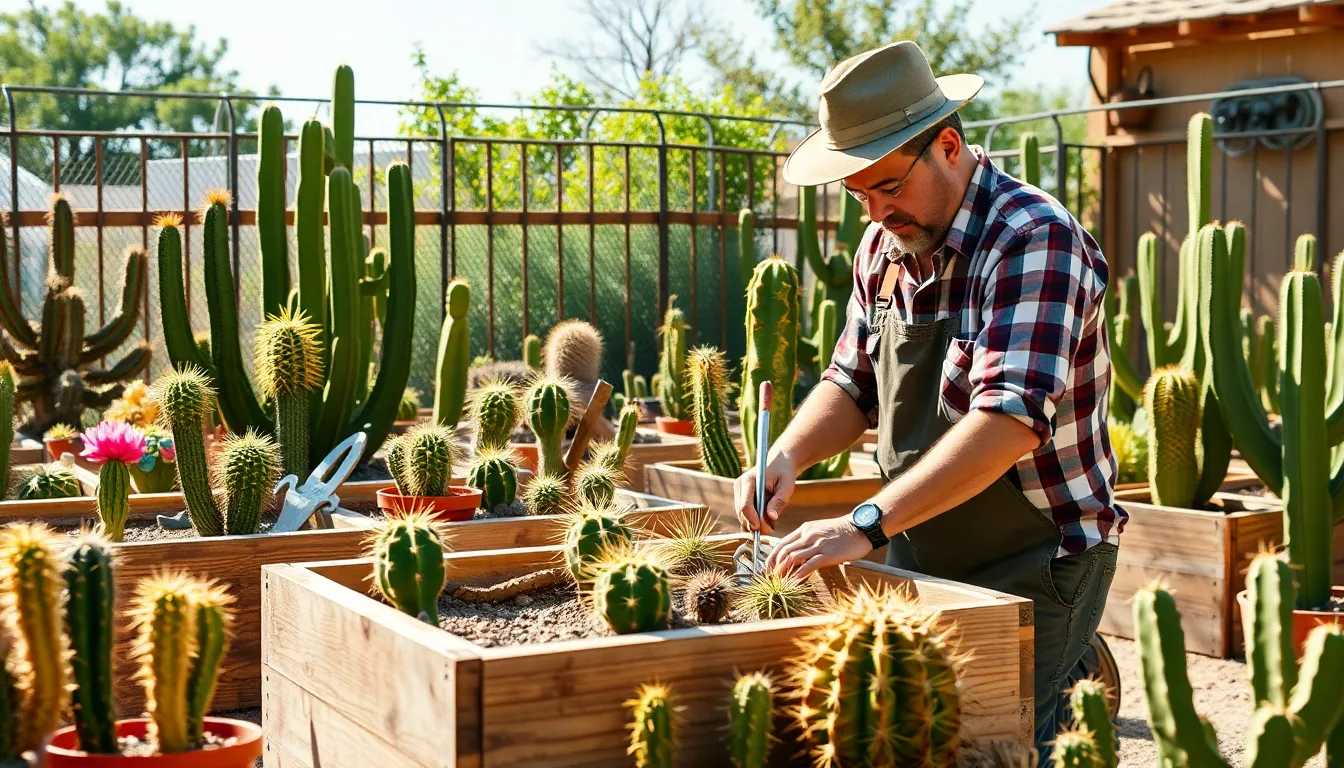
Raised beds become essential for cactus gardens because they prevent waterlogging by ensuring proper drainage. We’ll eliminate the risk of root rot that kills cacti when excess moisture accumulates around their delicate root systems.
Construct Wooden Frame Structures
Wooden frames define our garden boundaries while creating an organized appearance for our cactus collection. We recommend using cedar or redwood boards because these materials resist moisture and insects naturally. Building frames 8 to 12 inches high provides adequate depth for proper drainage while making maintenance easier.
Assembling corner brackets helps secure the wooden structure without requiring advanced carpentry skills. We suggest pre-drilling holes to prevent wood splitting when installing screws. Measuring the area carefully ensures our frame fits perfectly within the designated garden space.
Treating untreated wood with natural sealers extends the frame’s lifespan significantly. We avoid pressure-treated lumber because chemicals can leach into the soil and harm our cacti.
Install Proper Soil Mix
Well-draining potting mix specifically designed for cacti prevents root rot and promotes healthy growth throughout the growing season. We combine equal parts regular potting soil, coarse sand, and perlite to create optimal drainage conditions. Adding pumice or crushed granite improves drainage further while providing essential minerals.
Testing soil drainage becomes crucial before planting our cacti collection. We pour water into the prepared bed and observe how quickly it drains away. Proper drainage means water disappears within 30 minutes of application.
Avoiding regular garden soil protects our cacti from moisture retention problems. We never use potting mixes containing moisture-retaining crystals or high amounts of peat moss because these materials hold too much water.
Plan Adequate Spacing
Spacing plants properly allows air circulation that prevents fungal diseases from developing in our cactus garden. We leave 12 to 18 inches between small cacti and 24 to 36 inches between larger specimens. This spacing accommodates mature plant sizes while ensuring easy access for maintenance tasks.
Considering mature plant dimensions helps us avoid overcrowding as our cacti grow over time. We research each species’ expected size before determining final placement in our raised beds. Mapping plant locations on paper first prevents spacing mistakes that require transplanting later.
Maintaining clear pathways between plant groupings makes watering and inspection tasks manageable. We create walking spaces at least 18 inches wide to access all areas of our cactus garden comfortably.
Create Stunning Container Cactus Displays
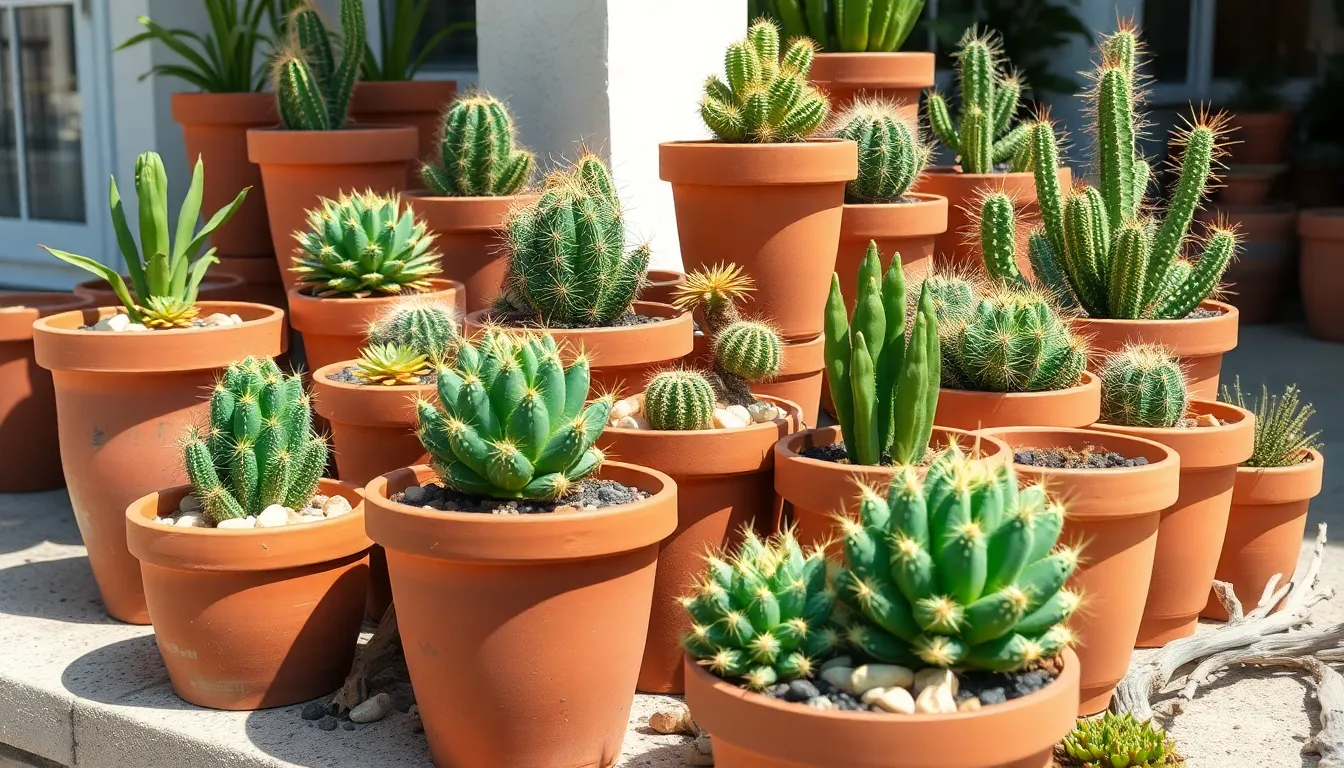
Container gardens offer incredible flexibility for showcasing our favorite cacti while maintaining complete control over growing conditions. They’re perfect for creating focal points throughout our space without committing to permanent planting locations.
Select Weather-Resistant Pots
Weather-resistant materials ensure our container displays withstand outdoor elements year-round. Terra cotta pots naturally regulate moisture levels and provide excellent breathability for cactus roots, while their classic appearance complements desert aesthetics perfectly. Plastic containers offer lightweight alternatives that resist cracking in freezing temperatures and maintain consistent moisture levels.
Drainage capabilities rank as the most critical factor when selecting containers for our cactus displays. We’ll need pots with multiple drainage holes to prevent waterlogging, which can quickly kill even the hardiest cacti. Adding gravel or pottery shards to the bottom creates additional drainage layers that protect roots from sitting in excess water.
Size considerations help us match containers to our exact cactus varieties and design goals. Large pots accommodate sprawling species like barrel cacti, while smaller containers work perfectly for compact varieties and grouping arrangements. We can create ever-changing displays by varying pot sizes within our collections.
Arrange Multi-Level Groupings
Layered arrangements using large and small pots create visually compelling displays with natural depth and dimension. We position taller containers in the back and shorter ones in front, mimicking natural industry formations that draw the eye through our entire display.
Height variations add architectural interest to our cactus container gardens while maximizing available space. Plant stands, inverted pots, or purpose-built risers help us create multiple levels that showcase each plant’s unique characteristics. This approach prevents smaller cacti from getting lost behind larger specimens.
Color coordination through pot selection enhances our overall design scheme while maintaining focus on the plants themselves. Neutral tones like terra cotta, stone gray, or matte black allow our cacti to remain the stars of the display while creating cohesive visual flow.
Design Portable Indoor Outdoor Options
Shallow container systems work exceptionally well for creating cactus gardens that can move between indoor and outdoor locations throughout the seasons. These containers provide adequate root space while remaining manageable for transport during harsh weather conditions.
Lightweight materials enable us to relocate our displays easily when weather threatens or when we want to refresh our space arrangements. Fiberglass and resin containers offer durability without the weight of traditional ceramic options, making seasonal transitions effortless.
Decorative enhancement elements like glass balls, polished stones, or driftwood pieces transform simple container displays into sophisticated design statements. We can incorporate these elements to create zen-like atmospheres or complement existing industry themes while adding visual interest between our cacti specimens.
Incorporate Complementary Desert Plants
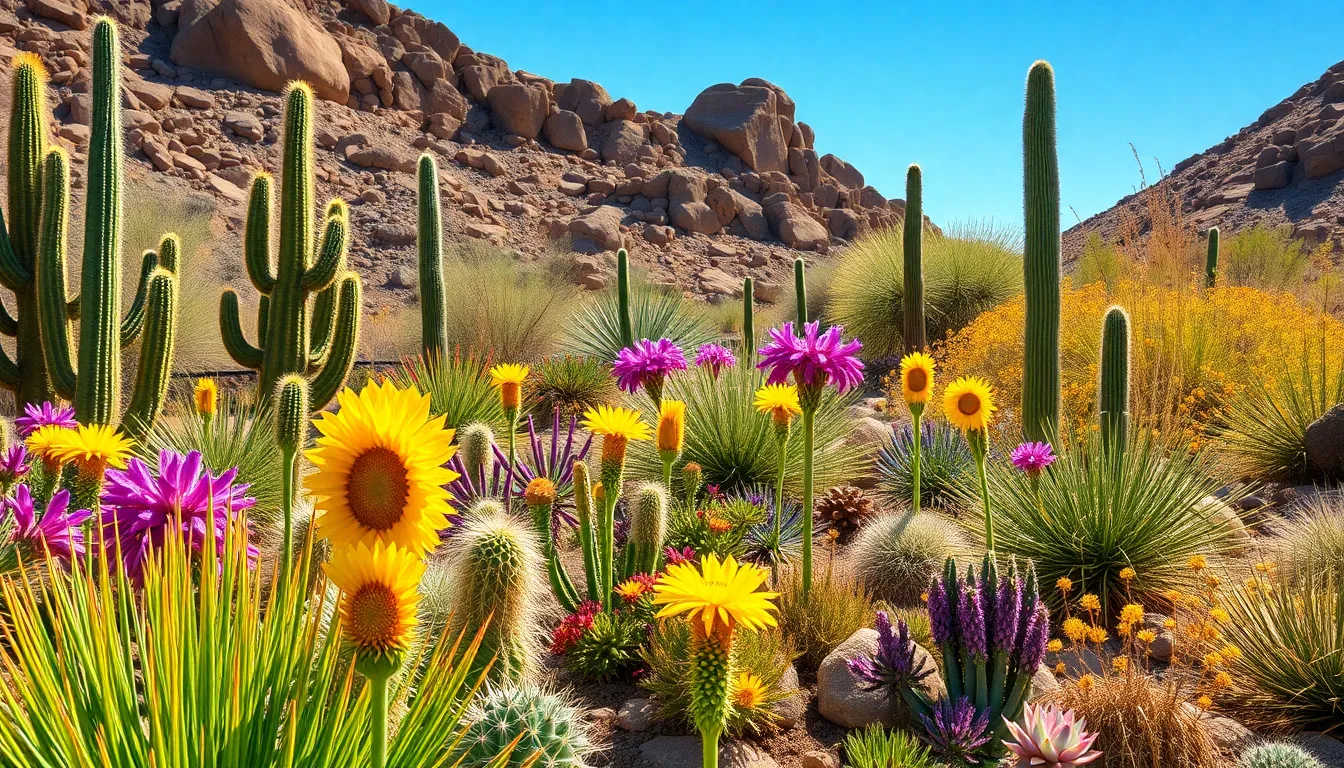
Creating a balanced cactus garden requires thoughtful plant partnerships that enhance both visual appeal and ecological harmony. We’ll explore strategic companion planting options that thrive alongside cacti while adding texture, color, and seasonal interest to your desert industry.
Add Drought-Tolerant Succulents
Succulents complement cacti perfectly due to their shared drought tolerance and minimal water requirements. Popular varieties include aloe, agave, and echeveria, each bringing unique textures and forms to your garden design. Mixing succulents with cacti creates a visually appealing and low-maintenance garden that requires watering only during extended dry periods.
Agave plants serve as excellent architectural elements with their bold, sculptural leaves that create striking focal points. Aloe varieties offer healing properties alongside their attractive rosette formations and occasional colorful flower spikes. Echeveria succulents provide delicate, rose-like shapes in various colors from blue-green to deep purple, creating beautiful contrast against spiky cactus forms.
We recommend grouping succulents with similar water needs together to simplify maintenance routines. Strategic placement of these drought-resistant companions fills gaps between larger cacti while maintaining the desert aesthetic throughout your garden space.
Include Native Grasses
Native grasses like blue grama and buffalo grass add natural texture while maintaining drought resistance essential for desert gardens. These grasses fill gaps between larger plants effectively, creating a seamless transition from cultivated garden areas to natural desert landscapes. Buffalo grass remains green longer during dry seasons, providing consistent ground cover throughout challenging weather periods.
Blue grama grass produces attractive seed heads that catch sunlight beautifully, adding movement and visual interest when gentle breezes flow through your garden. Native grass varieties require minimal irrigation once established, making them perfect partners for water-wise cactus gardens.
We suggest planting grasses in clusters rather than uniform rows to achieve a more natural, organic appearance. Strategic grass placement between rock features and along garden borders softens harsh edges while maintaining the authentic desert feel your cactus garden deserves.
Plant Colorful Desert Wildflowers
Desert marigold brings bright yellow blooms that create stunning contrast against green cactus pads and silvery succulent foliage. These hardy flowers bloom repeatedly throughout growing seasons, providing consistent color when many desert plants remain dormant. Brittlebrush offers similar yellow flowering benefits while requiring virtually no supplemental watering once established.
Lupine varieties bloom in early spring with purple, blue, and white flower spikes that add vertical interest to horizontal cactus forms. Desert wildflowers attract beneficial pollinators like butterflies and native bees, supporting local network health while improving garden biodiversity.
We recommend selecting wildflower varieties that naturally occur in your exact climate zone for best results. Seasonal wildflower displays create changing garden interest throughout the year, ensuring your cactus garden maintains visual appeal during different growing periods.
Install Low-Maintenance Landscape Features
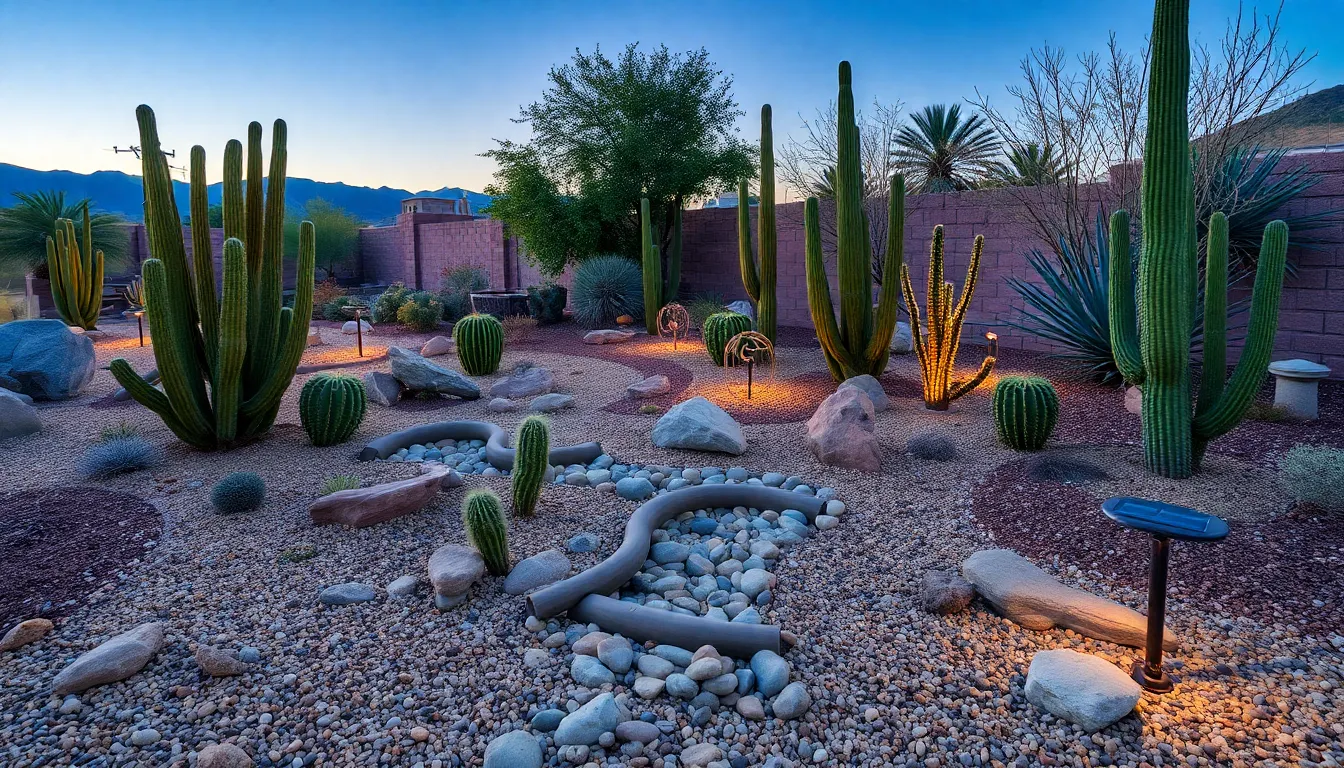
We can transform our cactus garden into a stunning desert oasis by incorporating features that require minimal upkeep while maximizing visual impact.
Build Decorative Dry Creek Beds
Creating a dry creek bed adds visual appeal to our cactus garden while improving its natural desert aesthetic. We start by sketching the creek bed’s winding path through our garden space, making it look like a natural water feature that dried up over time. Rocks and gravel form the foundation of this decorative element, with larger stones outlining the banks and smaller pebbles filling the center channel.
Different sized stones create depth and authenticity in our dry creek bed design. We place boulders strategically at curves to mimic natural erosion patterns, while smooth river rocks fill gaps between larger elements. The varying textures and colors of stones we select should complement our existing cactus varieties and hardscape materials.
Water drainage improves naturally when we construct these decorative features along our garden’s natural slope. Our dry creek bed channels rainwater away from sensitive cactus roots while creating an attractive focal point that draws the eye through the industry. Maintenance stays minimal since we only need to occasionally reposition stones and remove debris.
Create Artistic Metal Sculptures
Metal sculptures bring unique artistry and personality to our cactus garden while requiring zero watering or pruning. We can choose from abstract geometric shapes, stylized desert animals, or contemporary art pieces that complement our cacti’s natural forms. Weather resistant materials like corten steel or powder coated aluminum ensure our sculptures withstand harsh desert conditions without rusting or fading.
Placement of sculptural elements creates dramatic focal points throughout our garden design. We position larger sculptures as anchor pieces near major pathways or seating areas, while smaller metal art accents nestle between cactus groupings. The contrast between organic cactus shapes and angular metal forms adds visual interest that captures attention year round.
Artistic sculptures serve multiple functions beyond decoration in our low maintenance industry. Tall metal pieces provide vertical elements that break up horizontal garden lines, while sculptural screens create privacy without blocking airflow. Installation typically requires only simple concrete footings or weighted bases, making setup straightforward for most homeowners.
Add Solar-Powered Lighting
Solar powered lights illuminate our cactus garden during evening hours without increasing electricity costs or requiring complex wiring. We install these energy efficient fixtures along pathways to ensure safe navigation after dark while highlighting our most impressive cactus specimens. The automatic operation means our lighting system turns on at dusk and off at dawn without any manual intervention.
Strategic placement of solar lights creates dramatic shadows and silhouettes that transform our garden’s nighttime appearance. We position spotlights to uplight tall columnar cacti, creating striking vertical elements against walls or fences. Smaller pathway lights guide visitors through our garden while preventing accidental contact with spiny plants.
Modern solar lighting technology provides reliable performance even in desert climates with intense sun exposure. The rechargeable batteries in quality fixtures store enough energy during sunny days to power LED lights for 8 to 10 hours each night. Maintenance involves only occasional cleaning of solar panels and battery replacement every few years, keeping our lighting system truly low maintenance.
Plan Seasonal Care and Maintenance
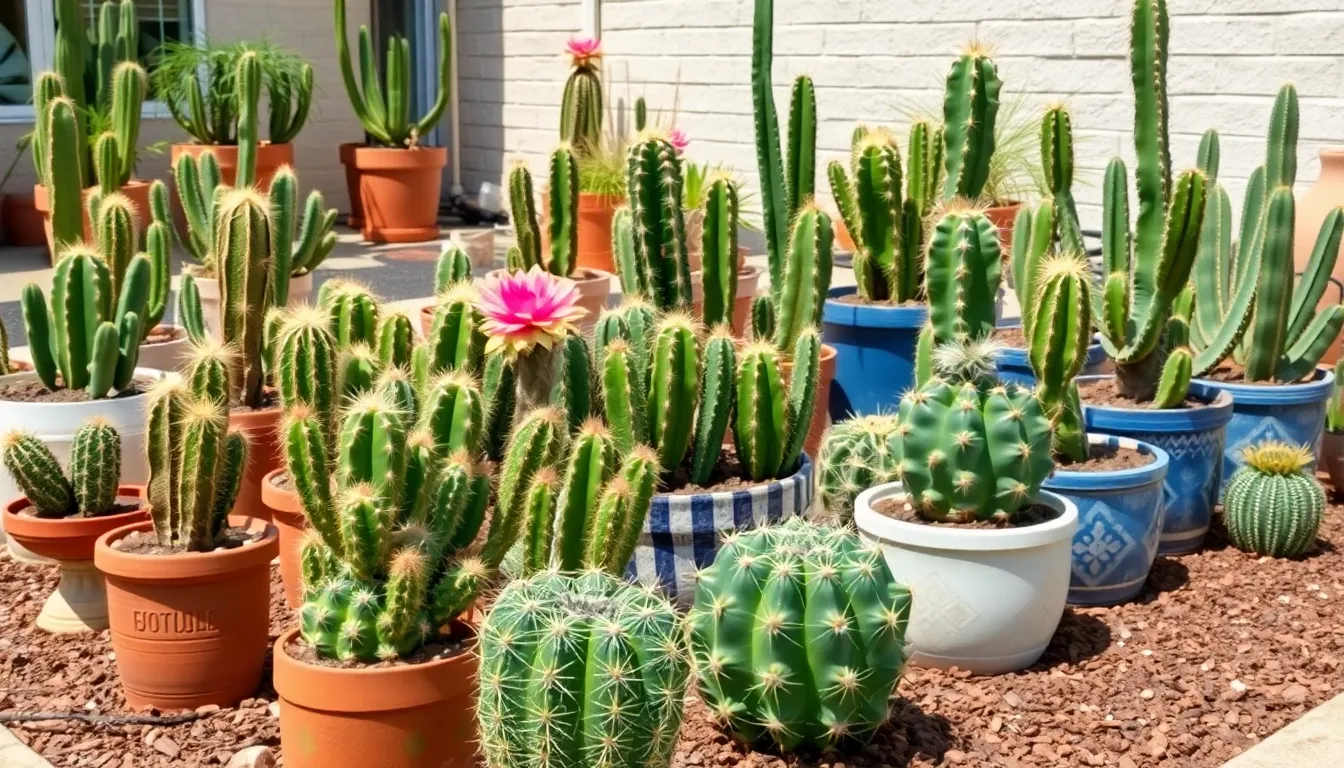
We need to adapt our cactus garden care throughout the year to ensure healthy growth and longevity. Seasonal changes require different maintenance approaches that align with natural growing cycles.
Schedule Proper Watering Routines
Water cacti sparingly during hot summer months when they’re actively growing and consuming more moisture. We should allow soil to dry completely between watering sessions to prevent root rot and fungal issues. Summer watering typically occurs every 2-3 weeks depending on temperature and humidity levels.
Reduce watering frequency significantly during winter months when cacti enter dormancy periods. We’ll water established cacti only once every 6-8 weeks during cold seasons since they require minimal moisture. Check soil moisture levels by inserting a finger 2 inches deep into the soil before adding water.
Monitor rainfall patterns to adjust our watering schedule accordingly throughout different seasons. We can skip scheduled waterings during weeks with adequate natural precipitation to avoid overwatering complications.
Carry out Winter Protection Strategies
Move potted cacti to sheltered areas like covered patios or unheated garages during freezing temperatures. We should bring tender varieties indoors when nighttime temperatures consistently drop below 32°F. Position indoor cacti near bright windows while reducing watering to match lower light conditions.
Apply mulch around in-ground cacti to protect root systems from freeze damage and temperature fluctuations. We’ll use materials like wood chips or gravel mulch in 2-3 inch layers around plant bases. Remove mulch in early spring to prevent moisture retention during warming periods.
Cover outdoor cacti with frost cloth or burlap during unexpected cold snaps or severe weather events. We should secure coverings without touching plant surfaces to prevent damage from fabric contact.
Plan Regular Pruning Tasks
Prune cacti in spring after new growth appears and temperatures stabilize above freezing consistently. We’ll remove dead or damaged segments using sterilized pruning tools to prevent disease transmission between plants. Cut damaged portions back to healthy tissue at natural joint connections.
Trim overgrown cacti to maintain desired shapes and prevent overcrowding in garden spaces. We should wear thick leather gloves and use long-handled tools to safely handle spiny varieties during maintenance tasks. Clean pruning cuts with rubbing alcohol between different plants.
Remove spent flowers and seed pods throughout growing seasons to encourage continued blooming and energy conservation. We’ll dispose of pruned materials in regular waste rather than composting to prevent pest issues in garden areas.
Design Themed Garden Sections
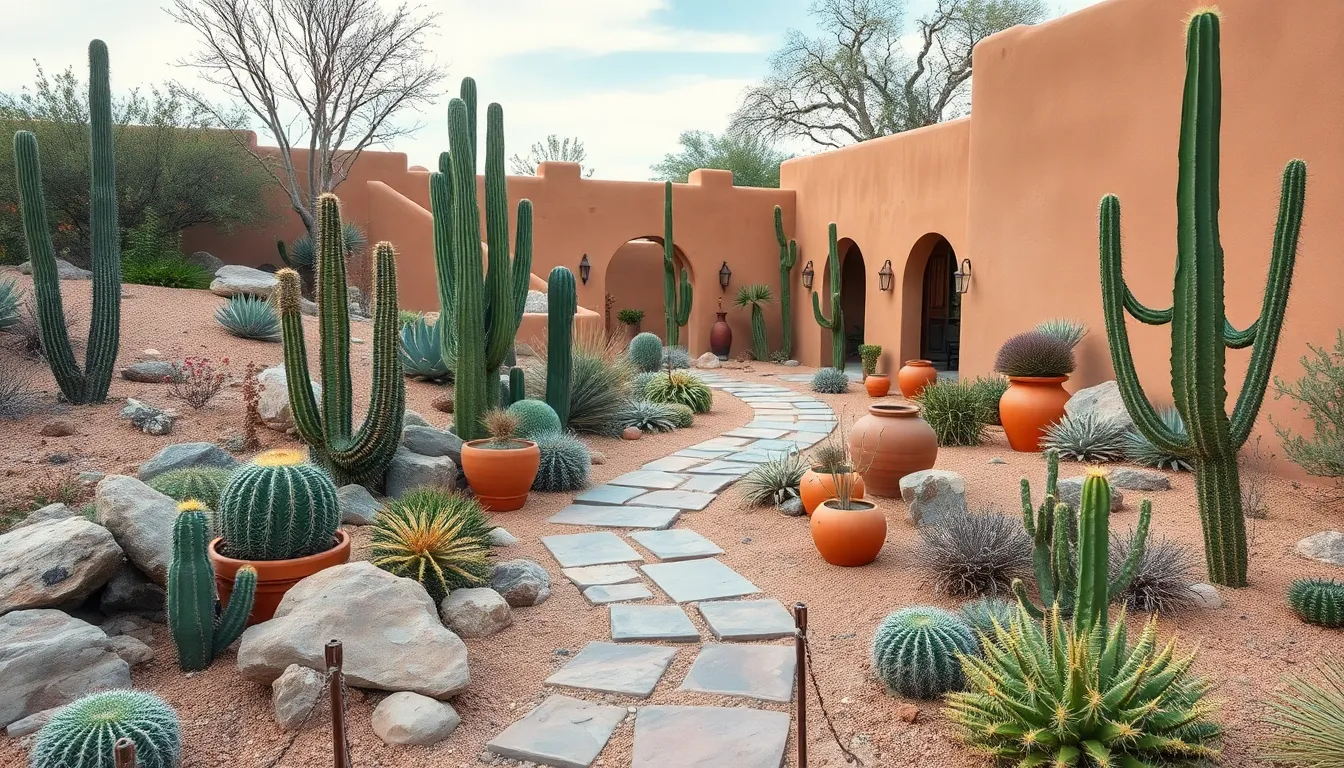
We can transform our cactus gardens into specialized zones that reflect different cultural aesthetics and design philosophies. Each themed section brings its own unique character while maintaining the low-maintenance benefits of desert landscaping.
Create Mexican Desert Zones
Authentic desert landscapes start with proper plant selection and natural hardscaping elements. We recommend combining native cacti varieties like barrel, saguaro, and prickly pear to create an authentic Mexican desert atmosphere. Large flat rocks and sand serve as foundational elements that mimic natural desert terrain while providing practical benefits for drainage and plant health.
Color coordination enhances the overall visual impact of Mexican desert zones. We suggest using warm earth tones throughout the design, incorporating terracotta pots and containers that complement the natural desert palette. Flowering cacti add vibrant seasonal accents during blooming periods, creating stunning color contrasts against the neutral backdrop.
Strategic plant clustering defines the Mexican desert aesthetic effectively. We position desert plants in natural groupings around central features like boulders or weathered driftwood pieces. This zoning approach creates visual anchors while allowing each plant specimen to maintain its individual character within the broader desert industry.
Build Southwestern Courtyard Areas
Hardscaping materials establish the foundation for authentic Southwestern design. We install flagstone or brick pathways that guide visitors through the garden while defining distinct plant zones. Adobe style walls and planters provide structural elements that reflect traditional Southwestern architecture and create intimate courtyard spaces.
Vertical elements add architectural interest and dimension to courtyard areas. We incorporate columnar cacti such as organ pipe and agave species to create height variations throughout the space. These tall specimens serve as living sculptures that draw the eye upward and establish visual hierarchy within the design.
Decorative accessories complete the Southwestern courtyard experience. We integrate pottery, wrought iron features, and glass ornaments that reflect traditional cultural motifs. These carefully chosen elements add personality and authenticity without overwhelming the natural beauty of the desert plants.
Design Modern Minimalist Spaces
Clean geometric lines define successful modern minimalist cactus gardens. We use geometric planters crafted from materials like metal or concrete to create structured plant displays. Monochromatic color schemes maintain visual simplicity while allowing the natural forms of cacti to serve as living art pieces.
Zen inspired features promote tranquility in modern minimalist designs. We incorporate smooth pebbles, sand areas, and carefully arranged cactus specimens to create peaceful meditation spaces. Sand rakes and minimal plant arrangements emphasize simplicity while maintaining visual interest through texture and form.
Vertical growing answers maximize space efficiency in urban settings. We use wall mounted planters and stacked container systems to create living walls that save ground space. These vertical gardens transform ordinary walls into striking displays that bring desert beauty to small patios, balconies, and modern courtyards.
Conclusion
Creating the perfect cactus garden doesn’t require endless hours of maintenance or extensive gardening expertise. We’ve shown you how proper planning—from selecting the right location and varieties to incorporating complementary design elements—sets the foundation for a stunning low-maintenance industry.
Whether you’re drawn to themed desert sections that reflect cultural aesthetics or prefer modern minimalist approaches with clean lines we’ve covered options that suit every style and space. The key lies in understanding your local climate choosing appropriate plants and implementing proper drainage answers.
Your cactus garden can become a year-round source of beauty that requires minimal intervention while maximizing visual impact. With the right combination of plants hardscaping features and seasonal care routines you’ll have created an authentic desert oasis that thrives with little effort on your part.
Frequently Asked Questions
What are the main benefits of creating a cactus garden?
Cactus gardens offer beautiful, low-maintenance landscaping perfect for busy homeowners. They require minimal water and care while providing year-round visual appeal. These gardens thrive in harsh conditions, making them ideal for areas with poor soil or limited rainfall. They’re cost-effective, environmentally friendly, and can enhance any space from small balconies to large backyards.
How much sunlight do cacti need to thrive?
Most cacti require at least 6 hours of direct sunlight daily to thrive. South-facing areas are ideal as they receive the most consistent sunlight throughout the day. Insufficient light can cause cacti to become stretched, weak, and lose their characteristic shape. However, some varieties can tolerate partial shade, so research your specific cactus types.
What type of soil is best for cactus gardens?
Cacti require well-draining soil to prevent root rot and waterlogging. Use a specialized cactus soil mix or create your own by combining regular potting soil with sand, perlite, and gravel. Avoid moisture-retaining materials and heavy clay soils. The soil should drain quickly after watering, allowing excess water to flow away from the roots.
Which cactus varieties are best for cold climates?
Cold-hardy cacti like Ocotillo, Chin cactus, and certain prickly pear varieties can survive frost and freezing temperatures. These species have adapted mechanisms to withstand harsh winter conditions. Research your local hardiness zone and select cacti rated for your specific temperature range. Consider providing additional winter protection during extreme cold snaps.
How should I space cacti in my garden?
Proper spacing prevents overcrowding and promotes air circulation, reducing fungal disease risks. Small cacti need 12-18 inches apart, medium varieties require 2-3 feet, and large cacti should be spaced 4-6 feet apart. Consider mature plant sizes when planning, as cacti grow slowly but can become quite large over time.
What are the best container options for cactus displays?
Choose weather-resistant containers with excellent drainage holes, such as terracotta, ceramic, or concrete pots. Ensure containers are appropriately sized for your cactus varieties and their growth potential. Avoid containers without drainage, as waterlogged soil is deadly to cacti. Consider grouping different sized containers for visual interest and layered arrangements.
How often should I water my cactus garden?
Water cacti sparingly during growing season (spring/summer) when soil is completely dry, typically every 1-2 weeks. Reduce watering significantly in winter to once monthly or less. Check soil moisture by inserting a finger 2 inches deep. Overwatering is more harmful than underwatering for cacti, so err on the side of caution.
What companion plants work well with cacti?
Drought-tolerant succulents like aloe, agave, and echeveria share similar water needs with cacti. Native grasses such as blue grama and buffalo grass fill gaps between larger plants. Desert wildflowers like desert marigold and lupine add seasonal color while attracting pollinators. Choose plants with similar water and light requirements.
How can I protect my cacti during winter?
Move potted cacti indoors when temperatures drop below their tolerance levels. For in-ground cacti, apply mulch around the base for insulation. Use frost cloth or temporary covers during extreme cold snaps. Reduce watering dramatically in winter, as cacti enter dormancy and are more susceptible to root rot in cold, wet conditions.
What hardscape elements enhance a cactus garden?
Natural stone pathways using flagstone or sandstone create defined walkways and plant zones. Decorative gravel mulch improves drainage while suppressing weeds. Sculptural boulders serve as dramatic focal points and create microclimates. Dry creek beds enhance drainage and visual appeal. These elements add structure and authentic desert aesthetics to your garden.

